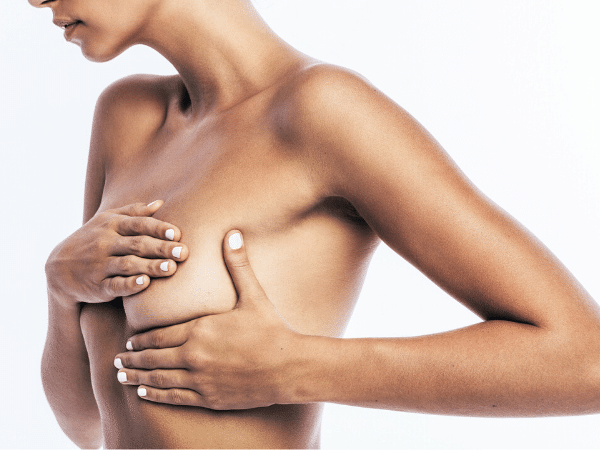Female breasts are considered the essence of femininity.
Breasts have been glorified for their beauty and ability to nourish new life. Breasts have also been vilified (e.g., breastfeeding in public). And, from bustiers and push-up bras, to silicone and saline implants, breasts have been objectified.
Yet…while breasts seemingly have a life of their own, they are a vital part of an integrated body system that reflects overall health.
Most of us know a friend or family member who has had breast cancer—or soon will. Yes, we should be aware of breast cancer. But it is even more important to understand how to keep your breasts healthy. Being pro-active about breast health can significantly lower your breast cancer risk or prevent you from getting breast cancer ever again (if you have already had it).
Breast Cancer: The Big Picture
In 2023:
» Among women: 297,790 new cases of invasive breast cancer are predicted (1). And an estimated 43,170 women will die from breast cancer (2).
» Among men, 2,800 new cases of invasive breast cancer are expected to be diagnosed (3).
» In the U.S., apx. 1 in 8 women versus 1 in 883 men will be diagnosed with invasive breast cancer over the course of her or his lifetime (4).
The statistics can sound daunting. And, if a family member has had breast cancer, it’s easy to feel anxious or fearful that you may be “next”.
The good news? Only 5 to 10% of breast cancer cases are linked to genetic mutations, like BRCA1 and BRCA2.
The vast majority (85%) of breast cancers occur in women (and men) who have NO FAMILY HISTORY of breast cancer (5).
This means that breast cancer risk can be mostly attributed to lifestyle, food choices and exposure to environmental toxins. Prevention is key! By making mindful choices about food, lifestyle habits, non-toxic products and ways of coping with stress, you can take charge of your breast health NOW.
If you’re unsure of your risk status, click on this link to check out The National Institute of Health’s breast cancer risk assessment tool.
Who Is At Risk
Personal factors that increase risk
The following are personal factors that can potentially increase breast cancer risk (6):
» First-degree relative with breast cancer. Having a first-degree relative (mother, sister or daughter) with breast cancer. One in 5 men with breast cancer have a close relative—male or female—with breast cancer.
» Father or brother. Having a father or brother who has had breast cancer increases breast cancer risk for women. For men, too.
» Having a personal history of breast cancer. If a woman has had cancer in one breast, she has a higher risk of developing a new cancer in the other breast or in another part of the same breast.
» Early onset of menses and/or late onset of menopause. Getting periods early (especially before age 12) OR going through menopause after age 55; in both cases, a woman has a longer lifetime exposure to estrogen and progesterone.
» Having dense breasts. it can be harder to see a tumor on a mammogram.
Lifestyle risk factors
» Oral birth control pills. Past or present use of hormonal birth control pills. *Risk increases the longer a woman has been using oral contraception, especially after 5 years (7).
» Hormone replacement therapy. Long-term use of combination hormone therapy featuring synthetic versions of estrogen and/or progesterone, such as Premarin and Provera (8, 9).
» Smoking. Includes former and current smokers, as well as those who are exposed to secondhand smoke (10).
» Overweight and obesity, especially if a woman gains weight as an adult. Having more fat tissue raises estrogen levels, increasing risk of breast cancer, especially in post-menopausal women. Being overweight or obese is also associated with unhealthy (high) levels of insulin (a fat storage hormone), linked with increased risk of breast cancer (11). Obesity is a risk factor for men, too. As of 2023, 42.4% of American adults (age 20+) are obese: 41.9% women and 43% men (12).
» Alcohol. Drinking alcoholic beverages of any kind—beer, wine, and spirts—increases a woman’s risk of hormone-receptor-positive breast cancer (13).
Compared to women who don’t drink at all, women who have three alcoholic drinks per week have a 15% higher risk of breast cancer. Experts estimate that the risk of breast cancer goes up another 10% for each additional drink women regularly have each day (14).
» Older age at birth of first child. The older a woman is when she has her first full-term pregnancy, the higher her risk of breast cancer (15).
» DDT (dichlorodiphenyltrichloroethane). A pesticide (synthetic insecticide), DDT was widely used from 1945 until it was banned in 1972; DDT is positively associated with breast cancer (16, 17).
» Exposure to agricultural pesticides. Historically, research has been inconsistent. However, recent studies find an association between exposure to organophosphate insecticides and increased risk of breast cancer.
One study and its follow-up found that the wives of agricultural workers who used pesticides had an increased risk of developing of breast cancer, especially pre-menopausal breast cancer (18). (Pre-menopausal refers to women who are still getting their periods regularly.)
Another study, published in International Journal of Cancer, found that women living in Long Island who had high levels of organochlorine insecticides in their bloodstream when they were diagnosed with breast cancer, were more likely to die 5 and 15 years after their diagnosis (19).
» Exposure to environmental breast carcinogens. Certain chemicals are linked to breast cancer: chemicals in gasoline, diesel, and other vehicle fuel; lawn equipment, tobacco smoke and burned or charred food; chemicals in food and drinking water; flame retardants, stain-resistant textiles and paint removers, among others (20).
Continue Reading About Breast Cancer Prevention (below):
Understanding Estrogen: How It Affects Breast Health (Part 2)
Protect Your Breasts: Limit / Avoid the Big 3 (Part 3)
Better Breast Health: Eat These 3 Foods (Part 4)
Sources
1, 3, 4 BreastCancer.org.
2 National Cancer Institute: Surveillance, Epidemiology and End Results Program. Cancer Stat Facts: Female Breast Cancer.
5, 6 Cancer.org.
7 American Journal of Lifestyle Medicine. 2018 Jan. 13.
8 Breast cancer and hormone replacement therapy: collaborative reanalysis of data from 51 epidemiological studies of 52,705 women with breast cancer and 108,411 women without breast cancer. Collaborative Group on Hormonal Factors in Breast Cancer. The Lancet. 1997 Oct 11;350(9084):1047-59.
9 Type and timing of menopausal hormone therapy and breast cancer risk: individual participant meta-analysis of the worldwide epidemiological evidence. Collaborative Group on Hormonal Factors in Breast Cancer. The Lancet. 2019 Sept. 29. Vol. 394. Issue 10204. pp: 1159-1168.
10 Breast Cancer. 2017; 9: 127–132.
11 Cancer Research. 2015 Jan. 15; 75(2): 270-274.
12 State of Childhood Obesity. Robert Wood Johnson Foundation.
13, 14 BreastCancer.org.
15 National Cancer Institute. Reproductive History and Cancer Risk. Nov. 9, 2016.
16 Asian Pacific Journal of Cancer Prevention. 2010;11(1):173-80.
17 The Journal of Clinical Endocrinology and Metabolism. Volume 100, Issue 8, 1 August 2015, pgs. 2865–2872.
18 Environmental Health Perspective. 2017 Sep 6;125(9):097002.
19 International Journal of Cancer. 2016 Feb 1;138(3):565-75.
20 Environmental Health Perspectives. 1 Sept. 2014, Vol. 122, No. 9.


